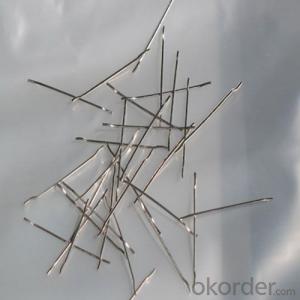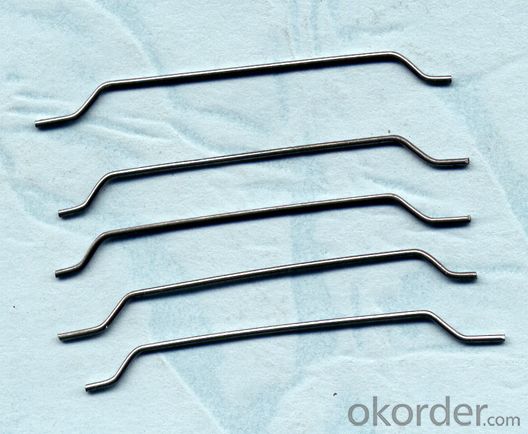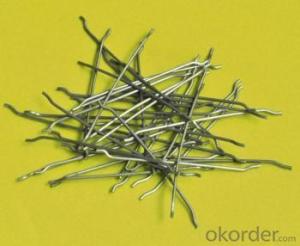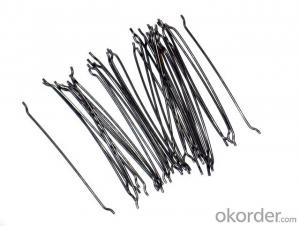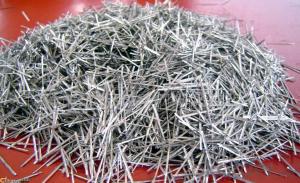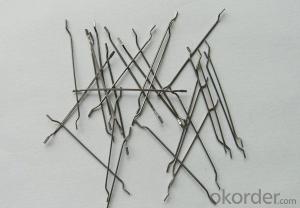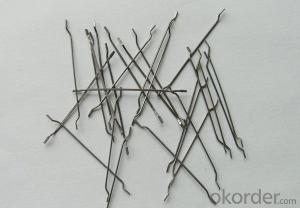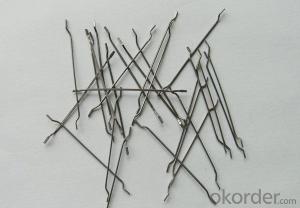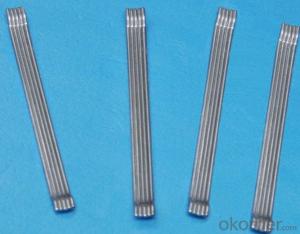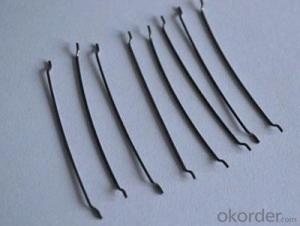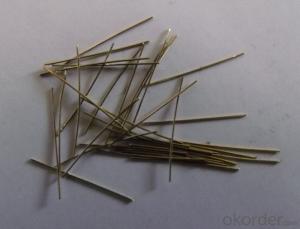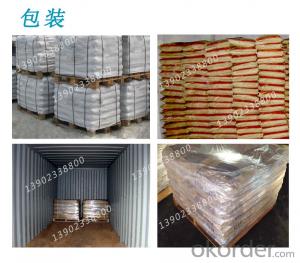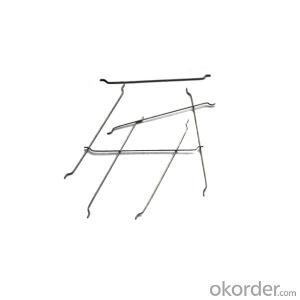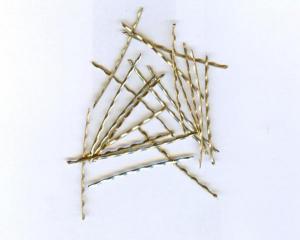Melt Extract Stainless Steel Fiber - Straight Type from CNBM China
- Loading Port:
- Tianjin
- Payment Terms:
- TT OR LC
- Min Order Qty:
- 1000 kg
- Supply Capability:
- 30000 kg/month
OKorder Service Pledge
OKorder Financial Service
You Might Also Like
Quick Details
Place of Origin: Shandong, China (Mainland)
Brand Name: CNBM
Model Number: LONGSTONE
Material: Stainless Steel
Specifications
Produces shear type, steel wire type, cut type, stainless type, and micro wire type steel fiber. It is used for concret.
SPECIFICATION
TYPE | SIZE | tensile strength |
ENDHOOKED STEEL FIBER | 0.5×0.5×30 mm | 850Mpa min |
0.6×0.7×35 mm | 850Mpa min | |
0.5×0.5×30 mm | 1000MPA min | |
0.6×35 mm | 1000MPA min | |
0.9×60 mm | 1000MPA min | |
CORRUGATED STEEL FIBER | 0.25×0.25×10 mm | 380Mpa min |
0.25×0.25×14 mm | 380Mpa min | |
0.5×0.7×32 mm | 380MPA min |
Picture
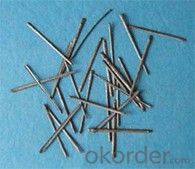
Steel fiber straight type
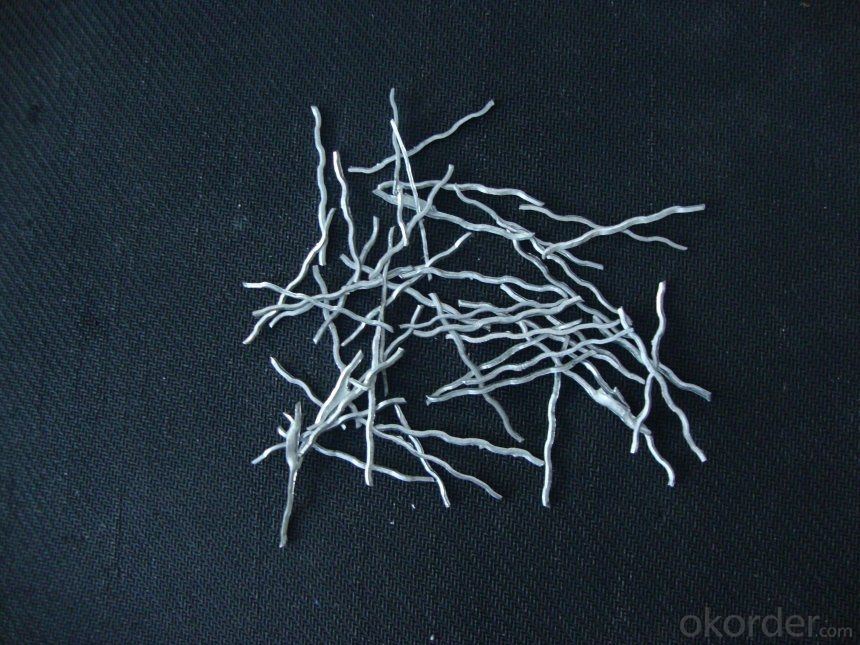

FAQ
certificated: ISO 9001
Technical advantages of Daye steel fiber:
A. Improve mechanical performance of concrete
B. Provide uniform distribution throughout concrete with excellent mixing
C. No balling or caking by adopt correct mixing method
D. Reduce concrete volume
E.Save construction time and cost
F.Reduce excavation volume
G.Available for jointless floor.
- Q: What is the effect of melt extract stainless steel fiber on the plastic settlement of concrete?
- The effect of melt extract stainless steel fiber on the plastic settlement of concrete is that it helps to reduce the settlement and improve the overall stability and durability of the concrete. The fibers are dispersed throughout the concrete mixture, providing reinforcement and improving its resistance to cracking and shrinkage. This results in less plastic settlement and a more robust concrete structure.
- Q: What are the main points of construction of steel fiber reinforced concrete?
- transportChoose a reasonable distance to set up the mixer to shorten the transportation time and distance of the steel fiber, preferably by pumping
- Q: Is melt extract stainless steel fiber compatible with various types of admixtures?
- Various types of admixtures can be used with melt extract stainless steel fiber, making it compatible. The versatility and compatibility of stainless steel fibers with different concrete admixtures are well known. This compatibility is a result of stainless steel's chemical properties, which provide resistance to corrosion and chemical degradation. By adding melt extract stainless steel fibers to concrete, the mechanical properties of the material are enhanced. This includes increased flexural and tensile strength, improved impact resistance, and reduced cracking. These fibers also contribute to the overall durability and longevity of the concrete. Melt extract stainless steel fibers can be utilized alongside various admixtures, such as superplasticizers, air-entraining agents, and water reducers. These admixtures are commonly employed to improve the workability, strength, and durability of concrete. The compatibility of stainless steel fibers with these admixtures allows for the customization and optimization of concrete mixes to meet specific project requirements. In conclusion, melt extract stainless steel fibers harmonize well with different types of admixtures and can be successfully incorporated into concrete mixes to enhance performance and durability.
- Q: Does melt extract stainless steel fiber improve the dimensional stability of concrete?
- Yes, melt extract stainless steel fiber does improve the dimensional stability of concrete. The addition of stainless steel fibers to concrete helps to reduce shrinkage, cracking, and overall dimensional changes that can occur due to environmental factors such as temperature fluctuations or moisture absorption. The fibers act as reinforcement within the concrete matrix, providing additional strength and preventing the formation of micro-cracks. This improved dimensional stability ensures that the concrete maintains its shape and integrity over time, increasing its durability and lifespan.
- Q: Can melt extract stainless steel fiber be used in earthquake-resistant concrete structures?
- Certainly, earthquake-resistant concrete structures can utilize melt extract stainless steel fiber. Renowned for their exceptional ductility and high tensile strength, stainless steel fibers are an ideal choice for bolstering the toughness and durability of concrete. The inclusion of these fibers in concrete enhances its ability to withstand cracking, shrinkage, and spalling during seismic events. The utilization of stainless steel fibers in earthquake-resistant concrete structures plays a crucial role in mitigating the adverse effects of earthquakes. Acting as reinforcement, these fibers augment the concrete's strength and hinder the propagation of cracks. This reinforcement fortifies the overall structural integrity of the concrete, rendering it more resistant to the dynamic forces unleashed by earthquakes. Furthermore, melt extract stainless steel fibers possess a high melting point, corrosion resistance, and exceptional thermal stability. These attributes render them suitable for long-term implementation in hostile environments, such as earthquake-prone regions. These fibers remain intact over time, ensuring the concrete structure's long-lasting durability and efficacy. Additionally, melt extract stainless steel fibers have undergone rigorous testing and have been proven to enhance the seismic performance of concrete structures. They conform to various international standards, such as ASTM and ACI, guaranteeing their quality and reliability. These fibers have successfully been employed in a diverse array of earthquake-resistant applications, including bridges, tunnels, high-rise buildings, and industrial structures. In conclusion, melt extract stainless steel fiber can indeed be employed in earthquake-resistant concrete structures. Its exceptional tensile strength, ductility, and resistance to cracking make it an outstanding reinforcement material for fortifying the durability and seismic performance of concrete. By incorporating stainless steel fibers into concrete, engineers can effectively bolster the resistance of structures to seismic forces, ensuring the safety and longevity of infrastructure in earthquake-prone regions.
- Q: Are there any limitations or disadvantages of using melt extract stainless steel fiber?
- Yes, there are several limitations and disadvantages of using melt extract stainless steel fiber. Firstly, one limitation is its high cost. Melt extract stainless steel fiber is more expensive compared to other types of steel fibers. This can make it less economical for certain applications, especially for large-scale projects. Secondly, the fiber length is typically short, which can limit the reinforcement effectiveness in certain applications. Longer fibers are generally more effective in enhancing the tensile strength and crack resistance of concrete. Therefore, melt extract stainless steel fiber may not be suitable for applications that require longer fiber lengths. Additionally, the mixing process can be challenging when using melt extract stainless steel fiber. Due to its short length and small diameter, the fibers tend to clump together during mixing, making it difficult to achieve a uniform fiber distribution within the concrete mix. This can result in uneven reinforcement and reduced effectiveness. Another disadvantage is the potential for corrosion. Although stainless steel is known for its corrosion resistance, it is not completely immune to corrosion. In certain aggressive environments, such as those with high chloride content or acidic conditions, the stainless steel fibers can still corrode over time. This can lead to degradation of the concrete's mechanical properties and reduced durability. Lastly, the use of melt extract stainless steel fiber may require modifications to existing construction practices. Contractors may need to adjust their mix designs and concrete placement techniques to accommodate the addition of fibers. This can result in increased complexity and potential delays in construction projects. In conclusion, while melt extract stainless steel fiber offers several advantages in terms of improving concrete's mechanical properties, it also has limitations and disadvantages. These include high cost, short fiber length, challenges in mixing, potential corrosion, and modifications to construction practices. Therefore, it is important to carefully consider these factors before deciding to use melt extract stainless steel fiber in a construction project.
- Q: Can melt extract stainless steel fiber be used in thin concrete overlays?
- Yes, melt extract stainless steel fiber can be used in thin concrete overlays. The addition of stainless steel fibers helps to improve the structural integrity and durability of the concrete overlay, making it more resistant to cracking and improving its overall performance.
- Q: Can melt extract stainless steel fiber be used in asphalt mixtures?
- Yes, melt extract stainless steel fiber can be used in asphalt mixtures. This type of fiber is commonly added to asphalt mixtures to enhance their mechanical properties and improve the durability and performance of the asphalt pavement. The stainless steel fibers can help reduce crack formation, increase resistance to rutting and fatigue, and enhance the overall strength of the asphalt mixtures.
- Q: How does melt extract stainless steel fiber improve the flexural toughness of concrete?
- Melt extract stainless steel fiber improves the flexural toughness of concrete by enhancing its resistance to cracking and increasing its ductility. The fibers act as reinforcement, distributing stress more evenly throughout the concrete matrix and bridging micro-cracks that may occur. This results in improved flexural strength and increased resistance to bending and other forms of mechanical loading, ultimately enhancing the overall durability and performance of the concrete structure.
- Q: Can melt extract stainless steel fiber be used in nuclear power plant applications?
- Yes, melt extract stainless steel fiber can be used in nuclear power plant applications. Its high melting point, corrosion resistance, and mechanical strength make it suitable for various applications in nuclear power plants, such as reinforcement in concrete structures, thermal insulation, and as a reinforcement material in high-temperature applications.
Send your message to us
Melt Extract Stainless Steel Fiber - Straight Type from CNBM China
- Loading Port:
- Tianjin
- Payment Terms:
- TT OR LC
- Min Order Qty:
- 1000 kg
- Supply Capability:
- 30000 kg/month
OKorder Service Pledge
OKorder Financial Service
Similar products
Hot products
Hot Searches
Related keywords
